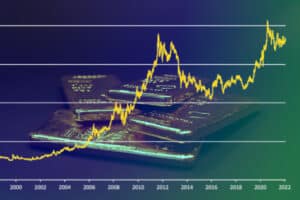Central banks around the world make important decisions that not only affect national economies but also impact global markets. The precious metals market, known for its stability amid economic turmoil, can also be significantly impacted, creating exciting opportunities for astute investors.
Keep reading to learn about the fascinating interplay between these two economic forces and gain insights that can illuminate your investment strategy. Whether you’re a seasoned investor or a curious novice, understanding these dynamics can equip you with the knowledge you need to navigate precious metals markets more effectively in the face of changing monetary policy.
Understanding Monetary Policy
Monetary policies are a central bank’s actions to adjust and control a country’s money supply. These methods generally fall under one of two categories, expansionary and contractionary, with their ultimate goals being to maintain price stability, control inflation, and promote economic stability.
The Role Of Central Banks In Setting Monetary Policy
Central banks strive to smooth economic fluctuations and seek price stability to ensure the smooth functioning of the economy. They set interest rates, manage the money supply, and regulate financial markets. Independent central banks are generally more successful in implementing effective monetary policy because they are free from political influence.
Additionally, central banks also have a profound influence on precious metals markets. Their decisions can trigger market movements that investors need to anticipate closely for successful trading. For example, changes in interest rates can increase the volatility of precious metals prices – a fact that any savvy investor should be aware of.
How Central Banks Implement Monetary Policies
One of the most common ways central banks implement monetary policies is through open market operations. This is where central banks buy or sell government bonds to influence the money supply.
Another method is changing the reserve requirement, which is the money banks must hold in reserve. By increasing the reserve requirement, central banks can decrease the amount of money that banks have available to lend, thus decreasing the money supply. Conversely, by reducing the reserve requirement, central banks can increase the amount of money that banks have available to lend, thus increasing the money supply.
Central banks can also use discount rates to implement monetary policy. The discount rate is the interest rate at which banks borrow money from the central bank. By changing the discount rate, central banks can influence the amount of money that banks have available to lend, thus affecting the money supply.
Expansionary Monetary Policy And Precious Metal Markets
As investors seek alternative investment opportunities, precious metals become increasingly attractive due to their value-stabilizing and inflation-hedging properties. Therefore, investors must remain informed and vigilant to manage these markets during periods of expansionary monetary policy effectively.
What Are Expansionary Monetary Policies
Expansionary monetary policies involve increasing the money supply through various mechanisms, such as lowering interest rates and encouraging borrowing and spending. By doing so, central banks can create an environment conducive to investment, innovation, and job creation.
During economic recessions or downturns, expansionary monetary policies can help reverse negative trends and spur economic growth. In such circumstances, businesses may be reluctant to invest or expand, and consumers may hesitate to spend money. This can lead to a vicious cycle of declining economic activity, unemployment, and reduced income.
To break this cycle, central banks use expansionary monetary policies to increase the money supply and reduce the cost of borrowing. Lower interest rates can encourage businesses to invest in new or expand existing projects, while consumers may be more likely to spend money on goods and services. This increased economic activity can create a virtuous cycle of growth, job creation, and rising incomes.
How Expansionary Monetary Policy Impacts Precious Metal Markets
High-yield investments such as bonds and savings accounts become less attractive to investors seeking alternative investment opportunities when interest rates fall. Precious metals such as gold and silver, which aren’t yield-bearing assets, become more attractive to investors because they serve as stores of value and hedges against inflation. As a result, demand for precious metals increases, leading to higher prices.
Additionally, expansionary monetary policy can lead to inflation if not managed effectively. In such cases, precious metals become even more attractive to investors as a hedge against inflation, further driving up demand and prices.
Real-World Examples Of Expansionary Monetary Policies
During the 2008 global financial crisis, central banks worldwide implemented expansionary monetary policies to stimulate their economies. This led to a significant increase in the prices of precious metals such as gold and silver.
Central banks worldwide also implemented expansionary monetary policies in response to the COVID-19 pandemic by lowering interest rates and increasing the money supply to mitigate the economic impact of the pandemic. This policy led to a surge in gold prices as investors sought safe investments during the economic uncertainty caused by the pandemic.
How Contractionary Monetary Policy Affects Precious Metal Markets
As interest rates rise and yield-bearing investments become more attractive, demand for non-yield-bearing assets such as precious metals may decline, resulting in lower prices. Therefore, investors should stay informed and vigilant to manage these markets during periods of contractionary monetary policy effectively.
Understanding What Contractionary Monetary Policies Are
Contractionary monetary policy is a tool central banks use to prevent inflation and slow down an overheating economy. This policy reduces the money supply by raising interest rates and making borrowing and spending less attractive. Contractionary monetary policy is implemented during periods of economic growth or high inflation rates.
When interest rates are high, people are less likely to take out loans to make purchases or investments. This reduces the overall demand for goods and services, which, in turn, lowers inflation.
Contractionary monetary policy is often seen as necessary to prevent an economy from spiraling out of control. Rapid economic growth and high inflation rates can lead to an unsustainable situation. This can lead to a vicious cycle of rising prices, reduced purchasing power, and a declining economy.
The Impact Of Contractionary Monetary Policies On Precious Metals
When interest rates rise, high-yield investments such as bonds and savings accounts become more attractive to investors, causing them to turn away from non-high-yield assets such as precious metals. This can lead to lower demand for precious metals, which can put downward pressure on their prices and create an opportunity for savvy investors to buy in at lower prices.
In addition, the reduction in money supply resulting from contractionary monetary policy may reduce inflation, which could reduce demand for precious metals as an inflation hedge. This could further contribute to lower demand and lower prices for precious metals.
Strategies For Investors To Handle Monetary Policy Changes
Navigating the financial markets in response to monetary policy changes can be challenging. However, with the right strategies, investors can capitalize on these changes and even protect their portfolios from potential risks.
Diversify Your Investment Portfolio
A well-diversified portfolio that includes a variety of asset classes can provide a hedge against market volatility, which is often triggered by monetary policy changes. The principle of diversification is based on the idea that a single economic event is unlikely to affect all asset classes equally.
Therefore, allocating investments among different asset types can help investors reduce the risk associated with a particular investment.
Stay Informed
As an investor, staying abreast of recent monetary policy changes is important to make informed decisions about your investment portfolio. However, it’s not enough to just know what changes are being made; it’s equally important to understand why these changes are being made and how they are likely to affect the economy.
In addition to monitoring monetary policy changes, staying informed about other economic indicators is important. These include GDP growth, inflation rates, and unemployment rates, for example. By keeping an eye on what’s happening in the economy, you can better understand how various factors affect the market and make more strategic investment decisions.
Consult A Financial Advisor
Central banks and other fiscal authorities’ decisions can significantly impact various asset classes such as stocks, bonds, and alternative assets. One way to gain a better understanding is to consult a financial advisor with the experience and knowledge to provide personalized advice based on an individual’s financial situation, goals, and risk tolerance. By working with a financial advisor, individuals can gain insight into the potential risks and benefits of different investment strategies and make informed decisions that align with their long-term financial goals.
Financial advisors can also help navigate the complexities of monetary policy and its impact on different asset classes. They can help individuals understand the various factors that affect interest, inflation, and exchange rates and how they may affect their investments.
The Role Of Gold As A Safe Haven Asset
Gold has long been considered a safe haven, meaning it’s an investment expected to retain or increase in value during economic or political turmoil. Gold is a finite resource that’s difficult to extract, making it a scarce and valuable commodity. Additionally, gold has been used for centuries as a store of value and a medium of exchange, giving it a historical track record of stability and reliability.
Investors often take refuge in gold and other safe-haven assets in economic uncertainty to protect their wealth. Gold isn’t directly tied to a country’s economy or currency, making it less vulnerable to market fluctuations. Instead, gold is considered a universal store of value that can help investors protect their assets in the face of economic uncertainty.
Gold also has a low correlation to other assets, such as stocks and bonds, making it a useful diversification tool for investors looking to mitigate risk in their portfolios. Gold often behaves differently than other assets during market downturns, providing a hedge against losses.
Hedge Against Market Changes With Precious Metal Investments
If you’re concerned about the impact of monetary policies on your hard-earned savings, investing in precious metals can be a wise and strategic move. Noble Gold Investments offers a wide range of options to fit all income levels, making it easier than ever to diversify your portfolio and protect your financial future.
Take control of your financial future and click here to open an account today. You can also call us at (877) 646-5347 and speak with one of our account managers about investing in physical bullion or investing it directly in a tax-advantaged Precious Metals IRA.







